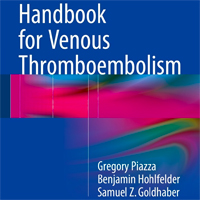Tag: thromboembolism
Anticoagulation Reversal Strategies for Warfarin Associated Acute Gastrointestinal Bleeding
Patients who received prothrombin complex concentrate (PCC) had a threefold increase in mortality compared to fresh frozen plasma (FFP), vitamin K alone, or no reversal, even after adjusting for severity of the bleeding.... read more
A Novel Mechanism for COVID-19 Related Thrombotic Events: Platelet NO/ROS Equilibrium
The finding that platelet NO/ROS production imbalance contributes to the elevated risk of thrombotic events in COVID-19 has important clinical implications. Restoration of platelet NO production, as well as attenuation... read more
Massive Pulmonary Embolism with Clot in Transit Using Fluoroscopic and Transthoracic Echocardiographic-Guided Large-Bore Mechanical Thrombectomy
Massive pulmonary embolism (PE) is a life-threatening condition caused by the obstruction of pulmonary arteries requiring precise and timely intervention to prevent mortality. Clots in transit (CIT), which are thrombi... read more
Diagnostic Value of Chest X-ray in Acute Pulmonary Thromboembolism
This case underscores the diagnostic value of chest X-ray in acute pulmonary thromboembolism (PTE), highlighting the significance of recognizing classical radiographic signs such as Westermark's, Palla's, Fleischner's and... read more
Different Anticoagulation Regimens Effectiveness in Critically Ill Patients
This study compared the efficacy of therapeutic anticoagulation guided by anti-Xa levels vs. a D-dimer-based protocol in ICU patients with COVID-19. Given the heightened risk of thrombosis despite anticoagulation therapy... read more
Thromboprophylaxis Preferences in the ICU
Low-molecular-weight heparin (LMWH) was the preferred agent for thromboprophylaxis in critically ill patients. There was considerable variation in the application of LMWH for prophylaxis, reflected by the use of different... read more
Handbook for Venous Thromboembolism
A truly practical guidebook for anyone who needs the key information on the diagnosis, management and prevention of venous thromboembolism. Specific areas of focus include understanding the risk factors for VTE and the role... read more

Venous/arterial Thromboembolism – Rare Side Effect Of Prothrombin Complex Concentrate
Venous/arterial thrombosis and pulmonary thrombosis accounts for very rare side effects of prothrombin complex concentrate and should be taken into account while administration. 68-year-old male with history of stroke,... read more
Anticoagulation Among COVID-19 Patients
In this prospectively designed meta-analysis of randomized trials, administration of therapeutic- compared with prophylactic-dose anticoagulation with heparins to patients hospitalized for COVID-19 was associated with 23%... read more
Atrial Fibrillation Status and Associations with Adverse Clinical Outcomes in COVID-19 Patients
COVID-19 patients with atrial fibrillation (AF) are at high risk of adverse clinical outcomes. Such patients may need increased surveillance and consideration for early anticoagulation. Patients admitted with COVID-19... read more
ECMO vs. Cardiopulmonary Bypass in Lung Transplantation
Extracorporeal membrane oxygenation (ECMO) offers perioperative advantages in lung transplantation, reducing postoperative complications, one-year mortality, and recovery time compared to CPB. However, the longer total ischemic... read more
Influenza-Complicated Thromboembolism in the ICU
Influenza-complicated thromboembolism (TE) among patients with severe influenza infection in the intensive care unit (ICU) is associated with increased risk for longer- duration mechanical ventilation, longer ICU stays, and... read more
VTE in Critically Ill Adult Patients with Hematologic Malignancy
Among patients with hematologic malignancy, critical illness and certain baseline characteristics were associated with a higher incidence of venous thromboembolism (VTE). Among 76,803 eligible patients (mean age 67 years... read more
Algorithm to Predict Thromboembolism in COVID-19 Patients
Patients with COVID-19 are at increased risk for thrombosis and might be stratified on admission based on lower Pao2/FiO2 ratio, higher D-dimer levels and history of major hemorrhages. 64 thromboses were recorded in 54... read more
Risk of Serious Blood Clots Up To 6 Months After COVID-19
A study from Sweden finds an increased risk of deep vein thrombosis (a blood clot in the leg) up to three months after COVID-19 infection, pulmonary embolism (a blood clot in the lung) up to six months, and a bleeding event... read more
Sepsis Hospitalization and Risk of Subsequent Cardiovascular Events in Adults
Adult sepsis survivors experience an increased hazard of major cardiovascular events compared to survivors of a non-sepsis hospitalization. 254,241 adult sepsis survivors were matched to adult survivors of non-sepsis hospitalization... read more
Anticoagulation Post-Discharge in Patients Hospitalized Secondary to COVID-19
This study contains interesting data that could contribute to the standard of practice when treating patients after hospitalization for COVID-19. However, use caution when applying the results of this study. Several problems... read more
Long-term Cardiovascular Outcomes of COVID-19
The cardiovascular complications of acute coronavirus disease 2019 (COVID-19) are well described, but the post-acute cardiovascular manifestations of COVID-19 have not yet been comprehensively characterized. Here we used... read more
Recognizing Vaccine-Induced Immune Thrombotic Thrombocytopenia
Vaccine-induced immune thrombotic thrombocytopenia is a serious complication of vaccination that is not feasible to anticipate or prevent. When the patient presents with sustained headache, neurologic symptoms/signs,... read more
A New Risk Assessment Model for Hospital-Acquired Venous Thromboembolism in Critically Ill Children
Using the multicenter Children’s Hospital-Acquired Thrombosis registry, we identified five independent risk factors for hospital-acquired venous thromboembolism in critically ill children, deriving a new hospital-acquired... read more
Subsegmental Pulmonary Embolism Increased Rate of Recurrent VTE
Overall, patients with subsegmental pulmonary embolism who did not have proximal deep venous thrombosis had a higher-than-expected rate of recurrent venous thromboembolism (VTE). Recruitment was stopped prematurely because... read more
Optimal Follow-up After Acute Pulmonary Embolism
This position paper provides a comprehensive guide for optimal follow-up of patients with acute pulmonary embolism (PE), covering multiple relevant aspects of patient counselling. It serves as a practical guide to treating... read more









